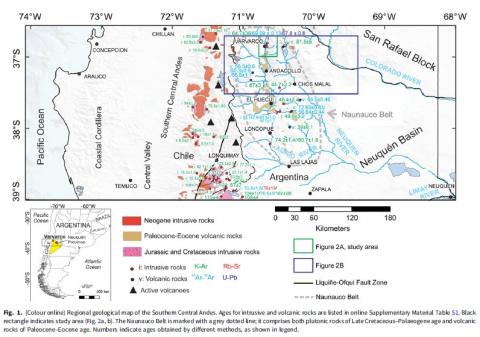Omar Sebastian Assis , Claudia Beatriz Zaffarana, Darío Orts, Carla Puigdomenech, Víctor Ruiz González, Gloria Gallastegui, Natalia Hauser, Ekaterina S. Kiseeva, José Francisco Molina and Sebastián Pernich
2 022
Geological Magazine, Volume 159, Issue 5, 14 March 2022
During the Late Cretaceous Andean orogeny, the compressive deformation associated with the shallowing of the subducting slab caused the development of the arc-related igneous rocks known as the Naunauco Belt. This study presents petrographic, mineralogical and anisotropy of magnetic susceptibility data for the Varvarco Intrusives (the Varvarco Tonalite, Butalón Tonalite and Radales Aplite), which crop out in the Cordillera del Viento, Neuquén Province, Argentina. The assembly of plutons was formed by mafic magma episodic injection. Amphibole and biotite compositions suggest that the Varvarco Tonalite is related to calc-alkaline, I-type magmas, typical of subduction environments. Different geothermobarometers based on amphibole and plagioclase compositions for the Varvarco Tonalite suggest shallow emplacement conditions (∼2–3 kbar, equivalent to ∼12 km depth). Apatite fission-track analyses give exhumation ages of 67.5 ± 8 Ma for the Varvarco Tonalite and 50.3 ± 5.9 Ma for the Butalón Tonalite. A calculated continuous fast exhumation rate of at least 330 °C Ma−1 is consistent with the shallow emplacement conditions, textural data and geobarometric estimations. In agreement with the thermal profile, the magmatic system was exhumed by ∼12 km within c. 2.1 Ma implying a geothermal gradient of ∼62.5 °C km−1. The last step of exhumation occurred between ∼65.3 and 56.9 Ma. The magmatic fabrics observed in the studied plutons reflect mostly magma chamber processes. The Varvarco Intrusives represent satellite calc-alkaline plutons of the North Patagonian Batholith which were emplaced syn- to post-tectonically with respect to a major deformation stage of the Southern Central Andes.

